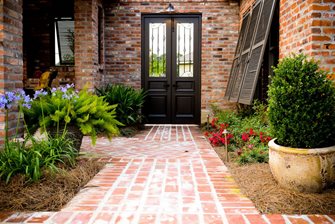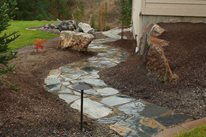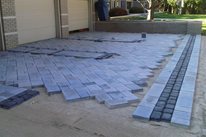Brick Installation
An overview of how to install brick paving
There are two common ways to install brick paving: dry laid or mortared. Dry laid bricks are more common, but mortared applications can be appropriate in certain circumstances. Your climate, site conditions and budget may dictate which installation method is best.
Installing Dry Laid Brick“In Southern California, we’ve got no frost-heave or freezing problems. We get away with dry laid brick - which doesn’t work in areas that freeze,” says Margie Grace of Grace Design Associates in Santa Barbara, Calif. Grace’s installation method is as follows: compact 4” of road base (class II), top with 1” of sand, lay brick, install edging, sweep sand into joints, and water in. “If we’re worried about expansive soil, we do a thicker base (6”+, depending on soil) so that the brick stays where we put it,” she continues.
Kyle Ritchey of Milieu Design in Wheeling, Ill. also prefers the dry laid installation method. “Dry laid brick is easy to repair and permeable,” he states. Beneath the brick, he uses grade 9 gravel because it compacts well, then fills the joints with torpedo sand. Ritchey cautions against using crushed limestone as a base material because it lowers the pH of the surrounding soil which can harm plants. “There is a slight risk in our climate that brick paving will shift due to freeze/thaw cycles, but if installed correctly this is rare,” he says.
| Dry Laid | Mortared | |
| Base | Compacted gravel and sand | Concrete slab |
| Joints | Filled with sand | Grouted |
| Repairs | Easy | Difficult |
| Cost | $10-15/sq. ft. | $13-20/sq. ft. |
| Permeability | Allows water to pass through | Water will run off & require drainage |
Installing Mortared BrickIf you’ve always wanted brick or are concerned about freeze/thaw issues, bricks can be mortared over both new and existing concrete slabs. “We’ve installed mortared brick on top of existing stoops and over concrete pool decks,” says Ritchey. The underlying concrete must be in sound structural condition, free of major cracks. Here are the steps involved in installing mortared brick:
- Over existing concrete: apply mortar to concrete, arrange bricks in chosen pattern and tap into mortar, check that bricks are level, pack more mortar into the joints between the bricks, scrape off excess mortar, tool the mortared joints, allow to set for four hours, clean any unwanted mortar that has dried off the surface of the bricks
- Over new concrete: form and pour concrete slab, allow concrete to cure sufficiently, apply mortar and fill joints in the same fashion as stated above for existing concrete
For slabs that have control joints, bricks must be carefully laid along these lines to ensure that unwanted cracks do not appear. Furthermore, precise measurements should be taken before laying bricks so that you’ll know whether cuts will be necessary and where to place the cut bricks. Hiring an experienced mason or landscape contractor to lay your brick will help you avoid such issues and ensure you get quality brick paving.
|
Contributing Author: Sarah Hutchinson, contributing writer for Landscaping Network |
An overview of preparing, pouring and finishing new concrete
Learn how to install dry laid or mortared flagstone paving
Learn the steps involved in installing a paver patio, driveway or walk
Return to Brick






 Installing Concrete
Installing Concrete Flagstone Installation
Flagstone Installation Laying Pavers
Laying Pavers

